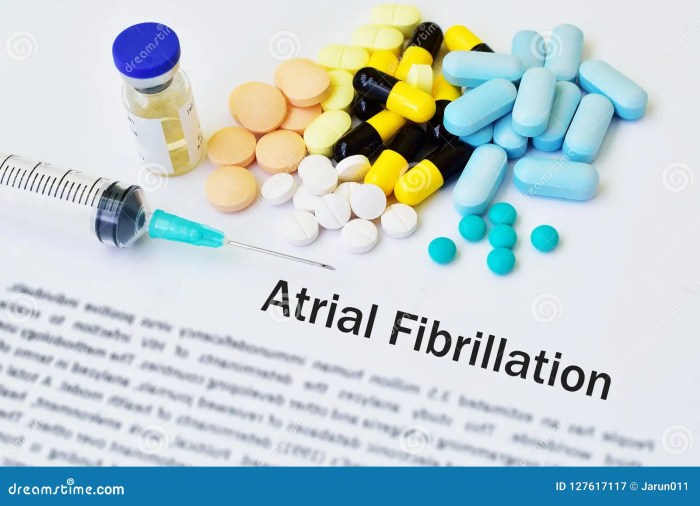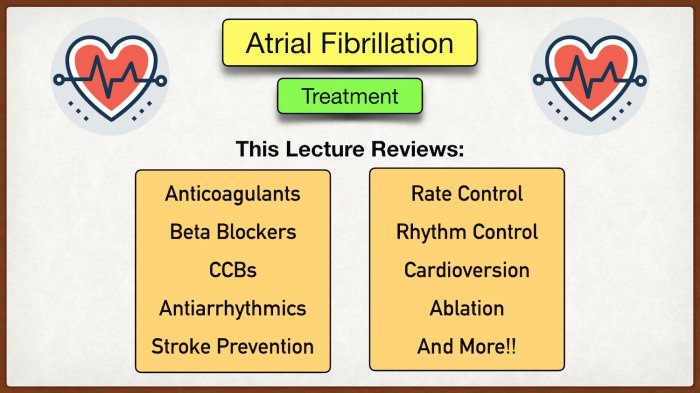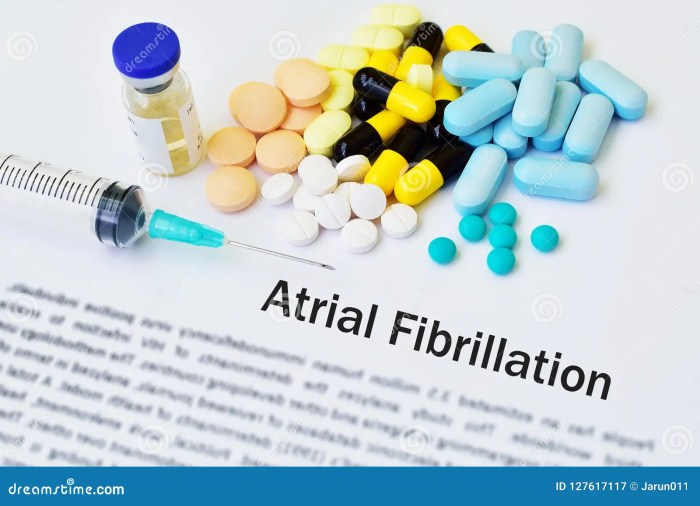How to reverse atrial fibrillation naturally is a crucial question for many seeking alternative or complementary approaches to managing this condition. This guide delves into potential lifestyle modifications, dietary recommendations, herbal remedies, nutritional considerations, and mind-body practices that may help. We’ll explore various strategies, but remember that natural remedies are not a substitute for professional medical advice. Consult your doctor before making any significant changes to your treatment plan.
Atrial fibrillation, a common heart condition, can significantly impact daily life. This comprehensive guide explores potential natural approaches, from dietary changes and exercise to herbal remedies and mindfulness practices. Understanding the potential benefits and risks associated with each method is key to informed decision-making.
Understanding Atrial Fibrillation

Atrial fibrillation (AFib) is a common heart rhythm disorder characterized by rapid, irregular heartbeats originating in the atria, the upper chambers of the heart. It’s a condition that can significantly impact daily life and, if left untreated, can lead to serious complications. Understanding AFib involves recognizing its symptoms, potential causes, and how it differs from other heart conditions.Atrial fibrillation occurs when the electrical signals in the atria become chaotic, causing them to quiver instead of contracting normally.
This irregular electrical activity leads to a rapid and irregular heart rate, often between 100 and 175 beats per minute, which can be felt as a fluttering or pounding sensation in the chest. The irregular heartbeat can also lead to decreased blood flow to the body’s organs, potentially causing complications.
Common Symptoms of Atrial Fibrillation
Recognizing the symptoms of AFib is crucial for early diagnosis and treatment. Common symptoms include palpitations (a feeling of a rapid, fluttering, or pounding heart), shortness of breath, chest discomfort or pain, fatigue, dizziness, lightheadedness, and weakness. Some individuals may experience no symptoms at all, a condition known as asymptomatic AFib. Symptoms can vary in intensity and frequency from person to person.
Potential Causes of Atrial Fibrillation
Several factors can contribute to the development of atrial fibrillation. These include underlying heart conditions such as high blood pressure, coronary artery disease, heart valve disease, and previous heart attacks. Other potential causes include certain medical conditions such as thyroid problems, sleep apnea, and lung disease. Lifestyle factors like smoking, excessive alcohol consumption, and lack of exercise can also increase the risk.
In some cases, the cause of AFib may remain unknown.
Types of Atrial Fibrillation (if applicable)
While AFib is broadly categorized as a single condition, variations in its presentation and duration are sometimes distinguished. Paroxysmal AFib refers to episodes of AFib that come and go, often resolving spontaneously. Persistent AFib involves AFib that lasts longer than 7 days, while permanent AFib indicates AFib that is ongoing and doesn’t respond to treatment. These distinctions are important for determining the appropriate management strategy.
Differences Between Atrial Fibrillation and Other Heart Conditions
| Characteristic | Atrial Fibrillation | Other Heart Conditions (e.g., Atrial Flutter, Heart Valve Disease) |
|---|---|---|
| Heart Rhythm | Irregular, rapid heart rate originating in the atria | Irregular or regular heart rate with different origins or patterns |
| Symptoms | Palpitations, shortness of breath, chest discomfort, fatigue, dizziness | Symptoms can vary widely depending on the specific condition (e.g., shortness of breath, chest pain, swelling) |
| Causes | Underlying heart conditions, medical conditions, lifestyle factors | Structural heart problems, infections, genetic factors |
| Treatment | Medication, lifestyle changes, procedures (e.g., ablation) | Medication, procedures, lifestyle changes depending on the condition |
This table highlights key differences in characteristics, symptoms, causes, and treatment approaches between atrial fibrillation and other heart conditions. Accurate diagnosis is critical for appropriate management.
Natural Approaches for Atrial Fibrillation Management

Atrial fibrillation (AFib) can be a challenging condition, but many lifestyle modifications can significantly impact its management. Natural approaches, combined with medical guidance, can often help reduce symptoms and improve overall well-being. These strategies focus on addressing underlying factors that contribute to AFib, rather than simply treating the symptoms.Natural approaches aim to improve cardiovascular health and reduce risk factors.
This involves changes in diet, exercise, stress management, and other lifestyle adjustments. While these approaches may not cure AFib, they can help manage symptoms and potentially reduce the need for medication or other interventions. Remember, always consult your doctor before making significant changes to your lifestyle, especially if you are taking medication for AFib.
Lifestyle Modifications
Lifestyle modifications are crucial for managing AFib. These changes can help reduce the triggers and improve overall heart health. Consistent efforts in these areas can have a noticeable impact on reducing symptoms and potentially improve long-term outcomes.
- Dietary Modifications: A heart-healthy diet can play a significant role in managing AFib. A diet rich in fruits, vegetables, whole grains, and lean proteins, along with limited intake of processed foods, saturated fats, and excessive sodium, is often recommended. Foods high in potassium, like bananas and leafy greens, can help regulate electrolytes, which can be important for heart health.
- Regular Exercise: Physical activity strengthens the heart, improves blood flow, and helps maintain a healthy weight. Regular exercise, such as brisk walking, swimming, or cycling, can help reduce the risk of AFib episodes. Aim for at least 150 minutes of moderate-intensity or 75 minutes of vigorous-intensity aerobic activity per week.
- Stress Management: Stress can trigger or worsen AFib episodes. Implementing stress-reducing techniques, such as yoga, meditation, deep breathing exercises, or spending time in nature, can significantly benefit AFib management. Stress reduction techniques can positively impact overall well-being and potentially decrease the frequency of AFib episodes.
- Adequate Sleep: Getting sufficient sleep (7-9 hours per night) is essential for overall health and can also influence AFib management. Sleep deprivation can increase stress hormones, impacting heart rate variability and potentially increasing the risk of AFib episodes.
Dietary Recommendations
A heart-healthy diet is vital for managing AFib. Reducing inflammation and improving blood vessel health are key benefits of dietary changes.
- Limit Processed Foods: Processed foods are often high in sodium, unhealthy fats, and additives, which can negatively impact cardiovascular health. Replacing these with whole, unprocessed foods is a positive change.
- Increase Potassium Intake: Potassium helps regulate electrolytes, which is important for heart function. Including foods like bananas, spinach, and sweet potatoes in your diet can help maintain potassium levels.
- Control Sodium Intake: High sodium intake can contribute to fluid retention and increased blood pressure, both of which can impact AFib. Monitoring and reducing sodium intake is beneficial for overall heart health.
- Choose Healthy Fats: Replacing saturated and trans fats with healthy unsaturated fats, found in avocados, nuts, and olive oil, can improve heart health and potentially reduce AFib risk.
Types of Exercise
Regular exercise is beneficial for maintaining heart health and potentially managing AFib.
- Aerobic Exercise: Activities like brisk walking, jogging, swimming, and cycling improve cardiovascular fitness and overall heart health. These activities help strengthen the heart muscle and improve blood flow, which are key factors in managing AFib.
- Strength Training: Strength training exercises, such as weightlifting or resistance training, build muscle mass, which can improve overall metabolism and cardiovascular health. Combining strength training with aerobic exercise creates a well-rounded approach.
- Mindful Movement: Practices like yoga and tai chi combine physical postures with breathing techniques, improving flexibility, balance, and reducing stress, all contributing to better heart health.
Stress Management Techniques
Stress can trigger or worsen AFib episodes. Implementing stress-reducing strategies can significantly benefit management.
- Mindfulness and Meditation: Mindfulness and meditation practices focus on present-moment awareness, helping to reduce stress and anxiety, both of which can impact heart health.
- Deep Breathing Exercises: Deep breathing exercises can calm the nervous system, reducing stress hormones and promoting relaxation, which can potentially improve AFib management.
- Yoga and Tai Chi: Yoga and tai chi combine physical postures, breathing techniques, and mindfulness, offering a holistic approach to stress reduction and improved heart health.
Effectiveness Comparison Table
| Lifestyle Modification | Potential Benefits | Potential Limitations |
|---|---|---|
| Dietary Modifications | Improved blood pressure, reduced inflammation, better electrolyte balance | Requires consistent effort and may require professional guidance |
| Regular Exercise | Improved cardiovascular health, weight management, reduced stress | May require gradual increase in intensity to avoid injury |
| Stress Management | Reduced stress hormones, improved relaxation, decreased anxiety | Requires consistent practice and may take time to see results |
| Adequate Sleep | Improved overall health, reduced stress hormones, potentially improved heart rate variability | Maintaining a consistent sleep schedule can be challenging for some |
Herbal Remedies and Supplements
Exploring natural approaches to atrial fibrillation management often involves the consideration of herbal remedies and supplements. While these options hold promise for some individuals, it’s crucial to understand that they are not a substitute for conventional medical care. Always consult with your doctor before incorporating any herbal remedy or supplement into your atrial fibrillation treatment plan. They can assess your specific health needs and potential interactions with existing medications.Herbal remedies and supplements, while purported to have various benefits, are not rigorously tested and regulated in the same way as pharmaceutical drugs.
This means that the quality, potency, and safety of these products can vary significantly. Always look for products from reputable sources and follow the recommended dosage instructions carefully.
Common Herbal Remedies for Atrial Fibrillation
Several herbal remedies are frequently used in the context of atrial fibrillation, although their efficacy is not always supported by scientific evidence. Some examples include ginseng, hawthorn, and valerian root.
Mechanisms of Action (Proposed)
Understanding the purported mechanisms of action of these remedies can help explain their potential benefits. For example, ginseng is thought to potentially improve blood flow and reduce inflammation. Hawthorn, on the other hand, may help strengthen the heart muscle and improve its function. Valerian root, often used for its calming effects, may indirectly influence the heart rate and rhythm.
Potential Benefits and Risks
While these remedies may offer potential benefits, potential risks are also important to consider. Ginseng, for instance, may interact with blood thinners, increasing the risk of bleeding. Hawthorn may also interact with certain medications, and individual sensitivities to herbal remedies can cause allergic reactions or other adverse effects. The long-term effects of herbal remedies on atrial fibrillation are not fully understood.
Always err on the side of caution and discuss any potential risks with your doctor.
Potential Interactions with Medications
Herbal remedies can interact with prescription medications, potentially altering their effectiveness or increasing the risk of side effects. For instance, ginseng can interfere with blood thinners, while hawthorn may interact with certain heart medications. It’s crucial to inform your doctor about all supplements you are taking, both herbal and otherwise, to avoid any potential drug interactions.
Summary Table: Safety and Efficacy of Herbal Remedies
| Herbal Remedy | Proposed Mechanism | Potential Benefits | Potential Risks | Interaction with Medications | Safety and Efficacy Assessment |
|---|---|---|---|---|---|
| Ginseng | Improved blood flow, reduced inflammation | Potential blood pressure regulation, stress reduction | Potential interactions with blood thinners, increased bleeding risk | Potentially interacts with blood thinners | Limited scientific evidence for efficacy in AF; use with caution. |
| Hawthorn | Strengthen heart muscle, improve function | Potential improvement in heart rate and rhythm | Potential interactions with heart medications, individual sensitivities | May interact with certain heart medications | Some evidence for benefit in improving symptoms, but further research needed. |
| Valerian Root | Calming effects, potential influence on heart rate | Potential reduction in anxiety and stress | Individual sensitivities, potential interactions with other medications | Potentially interacts with medications affecting the nervous system | Limited scientific evidence for efficacy in AF; use with caution. |
Nutritional Considerations
Nourishing your body with the right foods plays a crucial role in managing atrial fibrillation (AFib). A balanced diet rich in specific nutrients can contribute to overall heart health and potentially support the regulation of heart rhythms. This section delves into the vital role of specific nutrients, antioxidants, hydration, and various dietary approaches in mitigating the risk factors associated with AFib.Dietary choices significantly impact cardiovascular health.
A diet rich in fruits, vegetables, and whole grains, coupled with adequate hydration and specific nutrient intake, can potentially contribute to better heart rhythm management. Conversely, diets high in processed foods, saturated fats, and sodium can increase the risk of cardiovascular issues, including AFib.
Specific Nutrients for Heart Health
A healthy diet provides essential nutrients that support the proper functioning of the heart. Key nutrients include potassium, magnesium, and omega-3 fatty acids, each contributing to cardiovascular health in unique ways. Potassium helps regulate heart rate and blood pressure, while magnesium plays a role in muscle relaxation and nerve function, both crucial for a stable heart rhythm. Omega-3 fatty acids are known for their anti-inflammatory properties, potentially beneficial in reducing inflammation throughout the body.
Role of Antioxidants in AFib Management
Antioxidants combat oxidative stress, a process that damages cells and tissues. This damage can potentially contribute to the development and progression of AFib. Foods rich in antioxidants, such as berries, leafy greens, and citrus fruits, may help protect the heart from oxidative stress and maintain overall cardiovascular health. A diet rich in these foods can be beneficial for managing AFib symptoms and promoting long-term heart health.
While researching natural ways to reverse atrial fibrillation, I stumbled upon some interesting connections to migraine treatments. For example, exploring CGRP therapies, a specific type of migraine drug guidance, might offer valuable insights. CGRP therapies migraine drug guidance could potentially provide some helpful approaches to managing the underlying conditions that could affect both. Ultimately, though, reversing atrial fibrillation naturally likely involves a multifaceted approach encompassing diet, lifestyle, and potentially other medical interventions.
Importance of Hydration in AFib Management
Adequate hydration is essential for overall health, including cardiovascular health. Water helps regulate blood volume and pressure, which are critical factors in maintaining a healthy heart rhythm. Dehydration can lead to electrolyte imbalances, potentially contributing to AFib episodes. Maintaining proper hydration levels through regular water intake is vital for managing AFib.
Comparison of Different Diets and Their Effects
Different dietary approaches have varying potential effects on atrial fibrillation. A Mediterranean diet, rich in fruits, vegetables, whole grains, and healthy fats, has shown promise in improving cardiovascular health. A DASH (Dietary Approaches to Stop Hypertension) diet, focused on reducing sodium intake and increasing potassium, can help regulate blood pressure, potentially benefiting individuals with AFib. A low-sodium diet can help regulate blood pressure, a crucial factor in managing AFib.
A high-sodium diet, on the other hand, can increase blood pressure and potentially worsen AFib. It is important to note that the effects of specific diets on AFib can vary based on individual needs and factors.
Figuring out how to reverse atrial fibrillation naturally can be a journey, and sometimes unexpected connections emerge. While researching natural remedies for AFib, I stumbled upon fascinating correlations with hypoactive sexual desire disorder symptoms causes diagnosis treatment and coping. This resource highlights the interplay of stress, hormones, and overall well-being, which, in turn, can significantly impact heart health.
Ultimately, focusing on a holistic approach, including stress management techniques and a balanced lifestyle, seems key to reversing atrial fibrillation naturally.
Recommended Food Sources for Specific Nutrients
| Nutrient | Food Sources |
|---|---|
| Potassium | Bananas, sweet potatoes, spinach, avocado, yogurt |
| Magnesium | Spinach, almonds, cashews, pumpkin seeds, black beans |
| Omega-3 Fatty Acids | Fatty fish (salmon, tuna), flaxseeds, chia seeds |
| Antioxidants | Berries, leafy greens, citrus fruits, colorful vegetables |
Mind-Body Practices
Mindfulness and other mind-body practices can play a significant role in managing atrial fibrillation (AFib) by reducing stress and anxiety, which are often triggers for AFib episodes. These techniques can help regulate the autonomic nervous system, promoting a more balanced heart rhythm. By incorporating these practices into a holistic AFib management plan, individuals can potentially experience improved symptoms and overall well-being.Mind-body practices, including mindfulness, meditation, yoga, and Tai Chi, offer a pathway to address the emotional and physiological aspects of AFib.
While researching natural ways to reverse atrial fibrillation, I stumbled upon some interesting connections. It turns out that managing allergies might play a role in overall heart health, and choosing the right nasal sprays, like the ones reviewed in this article on best nasal sprays for allergies , could indirectly contribute to better heart health. This could potentially influence the natural approach to reversing atrial fibrillation, making it a holistic process.
These techniques are not a cure for AFib, but they can act as powerful tools for stress reduction and improved emotional regulation, ultimately contributing to a healthier heart and a better quality of life.
Mindfulness and Meditation
Mindfulness and meditation techniques cultivate present-moment awareness, allowing individuals to observe thoughts and feelings without judgment. This non-reactive approach can help calm the mind and body, reducing the physiological stress response that can trigger AFib episodes. Regular practice can lead to a greater sense of inner peace and emotional stability, which can positively influence heart health. Mindfulness exercises can involve focusing on the breath, body sensations, or external stimuli, promoting a sense of relaxation and composure.
Meditation techniques, such as guided meditations or mantra repetition, can further enhance these benefits by fostering a deeper state of tranquility.
Yoga and Tai Chi
Yoga and Tai Chi are gentle yet effective movement practices that combine physical postures (asanas in yoga) or flowing movements (in Tai Chi) with deep breathing and mindful awareness. These practices improve flexibility, balance, and strength, promoting overall physical well-being. Furthermore, the controlled breathing and focused attention inherent in these techniques can reduce stress and anxiety, which are known triggers for AFib.
Yoga poses can stretch and strengthen the muscles of the upper and lower body, while Tai Chi emphasizes fluid movements and balance, both promoting cardiovascular health.
Relaxation Techniques, How to reverse atrial fibrillation naturally
Relaxation techniques provide tools for calming the mind and body, reducing stress, and promoting a sense of well-being. Progressive muscle relaxation involves systematically tensing and releasing different muscle groups, fostering physical relaxation. Deep breathing exercises, such as diaphragmatic breathing, can calm the nervous system and promote a sense of calm. Visualization exercises involve mentally creating a relaxing image or scene, allowing individuals to focus on peace and tranquility.
These techniques can be particularly beneficial in managing the anxiety and stress that can contribute to AFib episodes.
Reducing Stress and Anxiety
Stress and anxiety are often implicated in the development and exacerbation of AFib. Mind-body practices can be instrumental in managing these emotions. By fostering a sense of calm and control, these techniques can help regulate the body’s stress response, thereby reducing the likelihood of AFib episodes. Developing coping mechanisms through these practices can help individuals better navigate stressful situations and maintain a more balanced emotional state.
Implementing these techniques into daily routines can lead to sustained improvements in stress and anxiety management.
Mind-Body Practices for AFib Management: A Summary
| Mind-Body Practice | Potential Benefits |
|---|---|
| Mindfulness | Reduced stress, improved emotional regulation, enhanced self-awareness |
| Meditation | Deepened relaxation, reduced anxiety, improved focus |
| Yoga | Increased flexibility, improved balance, reduced stress |
| Tai Chi | Improved balance, enhanced coordination, reduced stress |
| Relaxation Techniques (e.g., progressive muscle relaxation, deep breathing) | Physical relaxation, reduced anxiety, improved sleep |
Important Considerations and Disclaimers: How To Reverse Atrial Fibrillation Naturally
Natural approaches to managing atrial fibrillation (AFib) can be helpful adjuncts to conventional medical care, but they should never replace professional medical advice. Understanding the limitations and potential risks is crucial for anyone considering these methods. Remember, AFib can be a serious condition, and self-treating it without proper guidance can be dangerous.This section highlights the vital importance of seeking professional medical counsel before starting any new treatment, emphasizing the potential risks of self-treating AFib, and the necessity of regular medical check-ups.
It also stresses that natural remedies should not be considered a substitute for the expertise of a healthcare provider.
Consulting a Healthcare Professional
It is imperative to consult with a healthcare professional before initiating any new treatment, including natural remedies. They can assess your individual health status, identify potential interactions with existing medications, and determine if these remedies are appropriate for your specific situation. A doctor can also accurately diagnose the underlying cause of your AFib and recommend the most suitable course of action.
Risks of Self-Treating Atrial Fibrillation
Self-treating AFib can lead to several serious risks. Unnecessary or inappropriate remedies might interact negatively with prescribed medications, potentially leading to adverse effects. Furthermore, delayed or improper medical attention due to reliance on natural remedies alone could exacerbate the condition and lead to complications. Misdiagnosis due to self-treatment is also a significant risk.
Importance of Regular Medical Check-ups
Regular check-ups are crucial for monitoring the progression of AFib and adjusting treatment plans as needed. These appointments allow healthcare providers to assess the effectiveness of current treatments, detect any potential complications, and provide necessary guidance for ongoing management. Regular check-ups help to ensure that your AFib is managed effectively and safely.
Natural Remedies as Adjunctive Therapy
Natural remedies can potentially support overall health and well-being. However, they should never be considered a substitute for medical advice. They are adjunctive, meaning they should be used in conjunction with, not instead of, the prescribed treatment plan recommended by your healthcare provider. Be cautious about promoting natural remedies as cures for AFib without proper medical backing.
Important Warnings and Precautions
- Never discontinue prescribed medications without consulting your doctor. Sudden cessation of medications could worsen AFib symptoms.
- Be wary of herbal remedies and supplements that claim to cure AFib. They may not be backed by sufficient scientific evidence, and some may interact negatively with medications.
- Always consult a healthcare professional before taking any new supplement or herbal remedy, especially if you have other health conditions or are taking other medications.
- Be extremely cautious when using herbal remedies or supplements that claim to have a direct impact on the heart’s rhythm.
- Report any unusual symptoms or adverse reactions to your healthcare provider immediately. This includes changes in heart rate, chest pain, or shortness of breath.
- Do not rely solely on natural remedies for managing AFib. These remedies should be part of a comprehensive treatment plan overseen by your healthcare provider.
Illustrative Examples of Natural Approaches
Natural approaches to managing atrial fibrillation (AFib) often involve lifestyle changes and complementary therapies. These strategies can complement or support conventional medical treatments, promoting overall well-being and potentially reducing the frequency or severity of AFib episodes. By incorporating these practices into a daily routine, individuals can actively participate in their health management.Implementing natural approaches is not a substitute for medical advice.
It’s essential to consult with a healthcare professional before making significant changes to your treatment plan, especially if you’re currently taking medications for AFib. They can assess your specific situation and help you determine the best course of action.
Sample Daily Routine Incorporating Lifestyle Modifications
This daily routine emphasizes activities that promote heart health and reduce stress, common triggers for AFib. Consistency is key to experiencing the benefits.
- Morning (6:00 AM – 8:00 AM): Wake up gradually, avoiding sudden movements. Engage in gentle stretching or a short walk outdoors. Consume a balanced breakfast, including fruits, vegetables, and whole grains. This helps regulate blood sugar and blood pressure, factors associated with AFib.
- Midday (12:00 PM – 2:00 PM): Take a short break from work. Engage in a quick 10-minute walk or light exercise. Avoid large meals and stay hydrated throughout the day. This helps prevent blood clots and maintain healthy blood flow.
- Evening (6:00 PM – 8:00 PM): Have a light dinner, focusing on lean proteins and plenty of vegetables. Limit caffeine and alcohol intake in the evening, as these can trigger AFib episodes in some individuals. Engage in a calming activity like reading or listening to calming music.
- Night (8:00 PM onwards): Practice relaxation techniques, such as deep breathing or meditation, before bed. Aim for 7-8 hours of quality sleep. Adequate rest is crucial for overall health and reducing stress, a potential trigger for AFib.
Sample Weekly Meal Plan
This meal plan emphasizes heart-healthy foods, rich in nutrients that support cardiovascular health. It’s a template, feel free to adjust portion sizes and choices to your preferences and needs.
| Day | Breakfast | Lunch | Dinner |
|---|---|---|---|
| Monday | Oatmeal with berries and nuts | Grilled chicken salad with mixed greens and avocado | Baked salmon with roasted vegetables |
| Tuesday | Greek yogurt with fruit and granola | Lentil soup with whole-wheat bread | Lean beef stir-fry with brown rice |
| Wednesday | Whole-wheat toast with avocado and egg | Quinoa salad with chickpeas and vegetables | Chicken breast with quinoa and steamed broccoli |
| Thursday | Smoothie with spinach, banana, and almond milk | Turkey sandwich on whole-wheat bread with lettuce and tomato | Vegetarian chili with whole-wheat crackers |
| Friday | Scrambled eggs with spinach and whole-wheat toast | Tuna salad sandwich on whole-wheat bread | Baked cod with roasted asparagus and sweet potatoes |
| Saturday | Breakfast burrito with eggs, beans, and salsa | Leftovers from dinner | Homemade pizza with whole-wheat crust and vegetables |
| Sunday | Pancakes made with whole-wheat flour | Pasta salad with vegetables and lean protein | Chicken pot pie with whole-wheat crust |
Example Yoga Routine
This routine focuses on gentle poses that promote relaxation and improve circulation, beneficial for individuals with AFib. Modify poses as needed based on individual limitations.
- Child’s Pose (Balasana): A calming pose that stretches the hips and spine, reducing stress and promoting relaxation.
- Seated Forward Bend (Paschimottanasana): Stretches the hamstrings and back, improving flexibility and promoting blood flow.
- Cobra Pose (Bhujangasana): Gentle backbend that strengthens the back muscles and improves posture.
- Standing Forward Fold (Uttanasana): A grounding pose that stretches the entire body, improving circulation.
- Corpse Pose (Savasana): A final resting pose that allows the body to relax and integrate the benefits of the practice.
Simple Meditation Technique
This technique focuses on deep breathing to calm the mind and body. Find a quiet space and follow these steps.
- Find a comfortable position: Sitting or lying down, whichever is most comfortable.
- Close your eyes gently: Allow your body to relax.
- Focus on your breath: Notice the sensation of the air entering and leaving your body.
- Continue focusing on your breath: Allow any thoughts to pass without judgment.
- Repeat as needed: Practice for 5-10 minutes daily.
Visualization for Relaxation
Visualization involves creating mental images to induce a relaxed state. Choose a peaceful scene, such as a beach or a forest, and visualize it in detail.
Visualize yourself in a serene environment, feeling calm and at peace. Focus on the details of the scene, the colors, sounds, and sensations. Continue this visualization until you feel a sense of deep relaxation.
Closure
This exploration of natural approaches to atrial fibrillation management offers a range of strategies for potentially improving well-being and managing symptoms. Remember, these are suggestions, not guarantees, and are best considered in conjunction with conventional medical care. Always consult with your doctor before starting any new treatment or making significant lifestyle changes. Ultimately, a holistic approach that combines natural methods with medical guidance is crucial for effective management of this condition.







